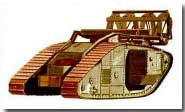Encyclopedia - Fascine Tanks
 Fascine is an ancient word used to
describe a bundle of wooden sticks. In circumstances of trench warfare
between 1914-18 fascine took on a fresh meaning and was associated with
ongoing tank development.
Fascine is an ancient word used to
describe a bundle of wooden sticks. In circumstances of trench warfare
between 1914-18 fascine took on a fresh meaning and was associated with
ongoing tank development.
So-called 'fascine tanks' would carry a fascine bundle on its roof, some 10 feet long and 4-6 feet wide. The fascine was closely rolled and bound by chains, and was released by the tank when it approached a trench. Upon falling the fascine (typically made of chestnut fence paling) would bridge the trench and enable the tank to cross unaided by rolling across the fascine.
Running through the centre of fascine bundles were three large pipes, designed to permit the flow of water throughout the bundle. Without this measure a fascine bundle dropped into a waterlogged trench or stream would otherwise act as a dam and turn the surrounding land boggy. The pipes rendered such a scenario less likely.
Where multiple tanks were scheduled to cross at the same point - particularly if the trench was more than usually deep or wide - each would drop its fascine bundle and cross at the same position.
Photograph courtesy of Photos of the Great War website
An Armlet was a cloth band worn around the arm to identify a particular duty or function.
- Did you know?
